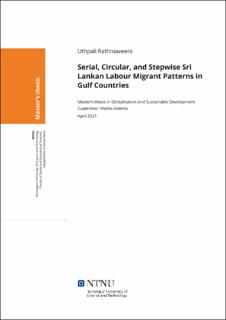| dc.description.abstract | Some of the world’s largest share of temporary migrant workers originate from Asian countries. In contrast, GCC countries are one of the largest receivers of temporary workers in the world. Due to the temporary nature of employment prospects in GCC countries, migrants are continuously engaged in various itinerary patterns. Circular, serial, and stepwise migrant itinerary patterns are such variations. This thesis explores circular, serial and stepwise migration trajectories of Sri Lankan labour migrants in the GCC countries. A variety of migrant motivations, goals, migrant strategies and drivers are identified in the study.
I have employed semi-structured interviews as the primary technique of my data collection method. I gathered data from Sri Lankan labour migrants who had worked in multiple locations in GCC countries, migrants who moved back and forth to Sri Lanka from a particular GCC country and migrants who have moved out of GCC (other than the home country). My interviewees represented skilled and semi-skilled categories. I have also employed other researches and government sources to support and strengthen my theoretical subjective findings.
Several theoretical models facilitated to construct my study, such as the push-pull theory and NELM theory supplemented with other relevant theories. These theories helped me to identify migrant drivers, migrant decision-making process in each migrant trajectory and the intrinsic and extrinsic forces needed to create recurrent migrant patterns. Despite of the temporary migration worker permits, I understood that Sri Lankan labour migrants engaged in multi migrations within and out of the region. This main characteristic influenced me to study about the different types of patterns rather than one migration journey. Therefore, I explored the re-migration journeys of each migrant and categorised in to circular, serial and stepwise migration concepts. In addition, I have explored individual and collective migrant aspirations, short-term or long-term goals, and migrant capital the results in sum produced the resultant of circular, serial and stepwise migrations or similar combination of migrant itinerary patterns.
Dissimilar social and human capital influenced migrant trajectories and several mobility patterns. My findings demonstrated that circular and serial migration patterns were more frequent than stepwise migrations due to the temporary nature of employment in GCC. A variety of migrant trajectories were chiefly influenced depending on the individual migrant capital, their aspirations and family and personal goals. A great deal of variation in migration drivers, forces and motives related to individual, and household level migration, eventually represented by economic transnationalism. Furthermore, these migrant strategies helped me to distinguish individual circular, serial, or stepwise migration mobility patterns. | |
